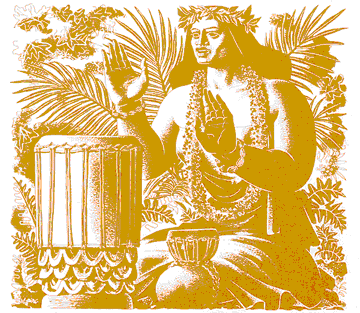

The traditional Hawaiian hula was performed for religious purposes to honor gods, ruling chiefs and their family history. The hula involved dances accompanied by mele (music, song, prayers and poetical chants) and a variety of sound-producing instruments, some of which were musical. Others were used to beat time for hula dancers. Poetry, vocal production, sounding of percussion instruments, dance movement and sculptured drums were combined into an aesthetic production that in its totality was greater than the sum of its parts.
The musical instruments used by the ho'opa'a (drummer and chanter) were the pahu hula (dance drum), the pa ipu (double calabash drum that was cemented with breadfruit gum) and the puniu (coconut shell knee drum). The latter instrument was made from a coconut (niu), hence the name puniu. The coconut shell was prepared by cutting the stem end off level above its middle, or greatest diameter, and a piece of shark skin membrane was lashed over the opening. The skin of the Kala (Acanthurus unicornis) fish was also used as the drumhead. The knee drum was tied above the knee with braided cords. A drum beater was made from a thick two-ply cord of coir fiber. This secondary drum was considered an extension of the pahu hula and the pa ipu. Eventually the puniu became an important object with distinctive sounds and conventions in its own right. The puniu was a percussion instrument endemic only to Hawai'i throughout Polynesia.
All 27 known ancient punius that are not of recent manufacture are in museum collections. Only one kilu puniu known in the museum collections was made of gourd. The rest of the puniu were made of coconut shell.
I will attempt to describe the methods of producing a puniu from a coconut shell. A more extensive description of the manufacture of the knee drum can be found in the Bishop Museum's publication entitled, "Arts and Crafts of Hawaii - Musical Instruments (ISBN 0-910240-42-6).
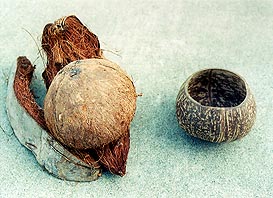
Use a round shaped coconut (niu wai) and husk it from its outer fibers. Save the fibers for plying into cordage for the lower ring. Traditionally, the husk from the nui lelo was used for cordage material. This variety of coconut had a long, angular fruit in which the proportion of husk was almost 70% of the weight of the fruit.
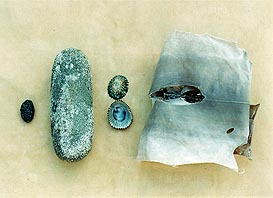
Materials for cleaning and sanding the coconut (left to right) - lava rock, pohaku 'anai (basalt stone abrader), 'opihi (limpet) shell and shark skin.
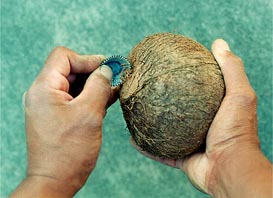
Scrape as much of the outer fibers clinging to the coconut shell as possible with the 'opihi shell.
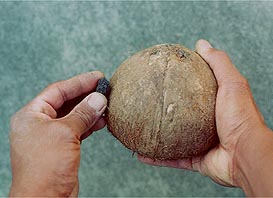
Abrade and remove the remaining husk fibers with the lava rock and the basalt stone abrader. Also a pumice stone was used for rough sanding.
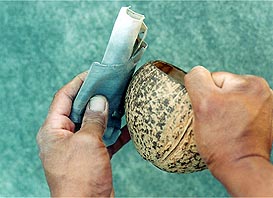
Cut the top area off the coconut (the section that has the eyes). Abrading and sanding is done with the shark skin. Dry or green 'ohe (Hawaiian bamboo) leaves and yellowed 'ulu (breadfruit) leaves were used for the final polishing.
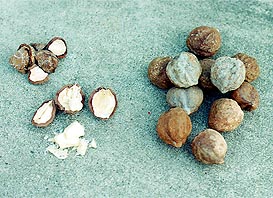
Kukui nuts for oiling the shell to a dark luster. The kernal of the kukui nut is about 50% oil and is of the same class of drying oils as linseed oil.
E-mail your comments to "Dino Labiste" at KahikoArts@yahoo.com
We hope the information on the PrimitiveWays website is both instructional and enjoyable. Understand that no warranty or guarantee is included. We expect adults to act responsibly and children to be supervised by a responsible adult. If you use the information on this site to create your own projects or if you try techniques described on PrimitiveWays, behave in accordance with applicable laws, and think about the sustainability of natural resources. Using tools or techniques described on PrimitiveWays can be dangerous with exposure to heavy, sharp or pointed objects, fire, stone tools and hazards present in outdoor settings. Without proper care and caution, or if done incorrectly, there is a risk of property damage, personal injury or even death. So, be advised: Anyone using any information provided on the PrimitiveWays website assumes responsibility for using proper care and caution to protect property, the life, health and safety of himself or herself and all others. He or she expressly assumes all risk of harm or damage to all persons or property proximately caused by the use of this information.
© PrimitiveWays 2013